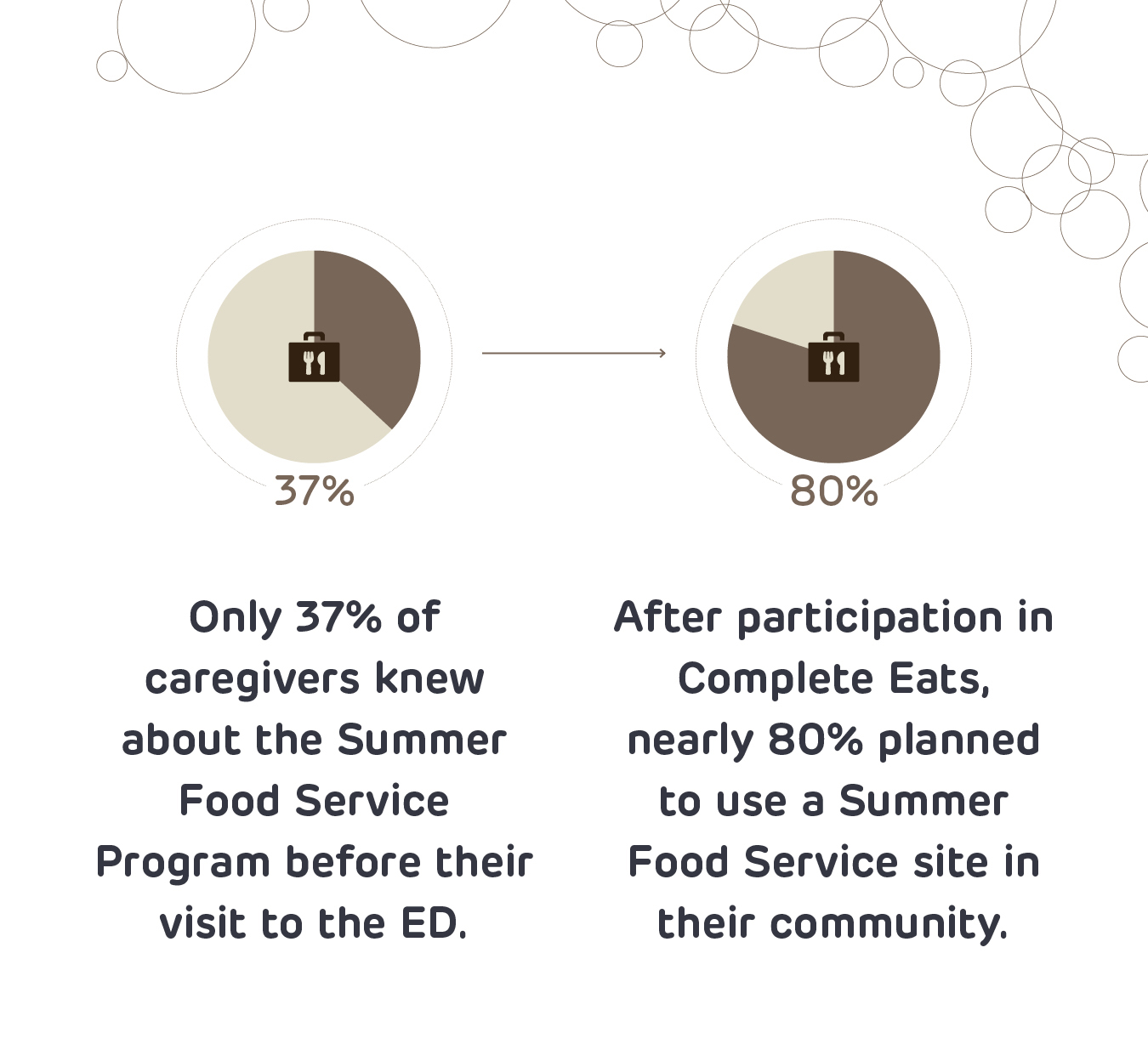Complete Eats: The USDA Summer Food Service Program at CHOP
Statement of Problem
In the United States, nearly 22 million low-income children depend on free or reduced-price meals during the school year. Unfortunately, while summer should be a time of carefree play, with loss of this programming, it’s too often a time of hunger. The U.S. Department of Agriculture (USDA) provides meals through the Summer Food Service Program, but many families either don’t know about or aren’t accessing the program. In Pennsylvania alone, only 1 out of every 10 students who use free and reduced-price school lunch accessed summer meals each year.
In Philadelphia, summer meals programs are available to all children 18 and younger, regardless of income and without an application. These programs can be particularly helpful in a city where more than 21% of children are food insecure, compared to less than 17% nationwide. Despite having more than 1,000 Summer Food Service Program sites across the city, many eligible kids don’t participate.
Description
Complete Eats: The USDA Summer Food Service Program at CHOP
Complete Eats: The USDA Summer Food Service Program at CHOP


Dr. Cullen and her colleagues were concerned about this discrepancy—they had seen the significant impact hunger could have on children’s physical and mental health. So, they decided to explore what was causing this gap and how they could help. Knowing the hospital is often one of the only institutions children come into contact with over the summer, Dr. Cullen and her team zeroed in on the emergency department (ED) as a setting to provide meals for kids, particularly those in low-income and high-risk families.
In 2017, along with Children’s Hospital of Philadelphia (CHOP) colleagues and community partners, Dr. Cullen’s team created the program called Complete Eats: an implementation of the Summer Food Service Program in CHOP’s ED. (Partners included: CHOP Clinical Sites and CHOP Career Path; Nutritional Development Services of the Archdiocese of Philadelphia; Pennsylvania Departments of Education and Health; and USDA.) Their goals were to determine whether the hospital was a feasible location to operate a summer meals program, whether it was acceptable to caregivers and if the program was able to successfully connect families with community resources to improve food security.
Once roomed in the ED, a patient and all kids between the ages of 2 and 18 in the room received a meal ticket that they could exchange for a balanced boxed lunch and information on additional summer meal sites and food resources in their community. Interns from CHOP’s Career Path program, a supported employment program for individuals with disabilities and/or chronic illnesses, distributed the food. The researchers then recruited caregivers to participate in a brief, voluntary, anonymous survey.
Over a six-week pilot period in the summer of 2017, the team distributed nearly 370 meals to patients and siblings in the ED with no reported disruption to clinical care. Nearly 90 caregivers completed the survey, giving the program high ratings—91% agreed there was a need for a program like Complete Eats, and 86% felt that the hospital was a good location to provide meals for children. More than 90% indicated the process was easy and they felt comfortable that it was administered in the ED.
The researchers also evaluated caregivers’ awareness about the federal Summer Food Service Program, which previous research showed to be a major barrier to participation. Only 37% of caregivers knew about the program before their visit to the ED. However, after participation in Complete Eats, nearly 80% planned to use a site in their community and most felt confident they could find a location.
The data showed that providing meals in a clinical setting through Complete Eats was feasible and acceptable, and had significant potential to enhance the reach of the federal Summer Food Service Program in Philadelphia. Strong clinical-community partnerships allowed the program to thrive and following the pilot program, CHOP expanded Complete Eats to include five outpatient clinical settings, serving over 20,000 meals each summer.
These partnerships additionally allowed rapid ramp-up amid school closures during the COVID-19 pandemic in 2020. The program operated nearly continuously from March 2020, serving over 80,000 meals and helping connect families with needed federal and community emergency food assistance programs, and will continue through summer 2021. In the summer of 2020, over 40% of program participants reported food insecurity, and a strong desire for additional food resources. With the information provided by Complete Eats, 52% of participants had repeat use of the free meal program either at CHOP or within their community. Among repeat participants, there was a 68% decrease in reported concerns about food access within a 30-day period, with the largest impact among those using the program each weekday.
Next Steps
Complete Eats continues to expand. Dr. Cullen and her team are completing a formalized evaluation of the effectiveness and implementation of the program. They hope to continue the success of Complete Eats to reach children across the city with healthy meals to help them grow and thrive, and that this program can serve as a model for other health care institutions across the country.
To find a Summer Food Service Program site near you—anywhere across the country—text “Food” to 877-877.
This project page was last updated in May 2021.
Suggested Citation
Children's Hospital of Philadelphia, PolicyLab. Complete Eats: The USDA Summer Food Service Program at CHOP [Online]. Available at: http://www.policylab.chop.edu [Accessed: plug in date accessed here].